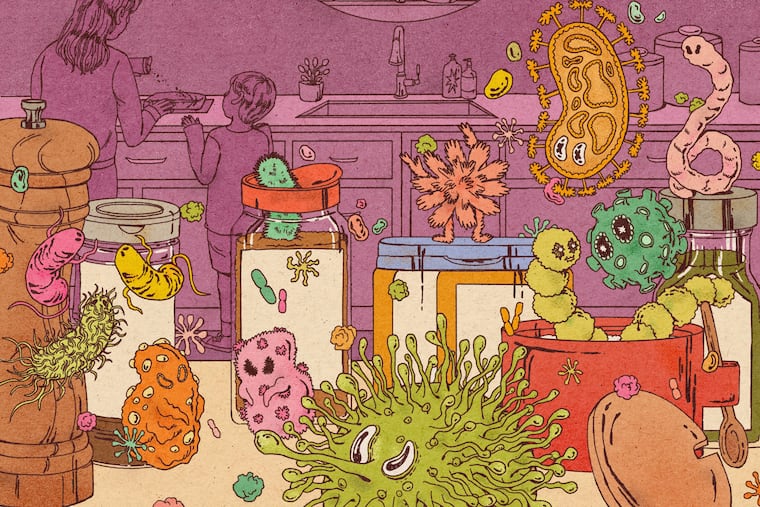Spice containers are the most contaminated surface in your kitchen
The most contaminated surface in your kitchen may be an unlikely suspect.

Prepping a turkey for Thanksgiving? A Philadelphia-area researcher wants home chefs to be aware of a hidden danger for foodborne illness lurking in unexpected corners of kitchens: the spice rack.
Spice containers are more than twice as likely as any other kitchen surface — including cutting boards, faucets and trash cans — to be cross-contaminated with bacteria from raw meat, according to a new study involving researchers from Rutgers University.
People tend to focus on internal temperature and cooking times to ensure that their food is safe, but the research findings are a startling — and gross — reminder that cleaning and sanitizing food prep spaces, as well as diligent hand washing, are also critical.
“There’s a lot unseen when you’re preparing food. Bacteria are moving all over the place,” said Britanny Saunier, executive director of the Partnership for Food Safety Education, a public health organization in Virginia that was not involved in the study.
» READ MORE: A bite of raw cookie dough led to years of E. coli side effects for this South Philadelphia woman
Illnesses linked to food sicken millions
Nearly two million people a year are sickened by foodborne illnesses, such as salmonella, listeria and E. coli, according to the U.S. Centers for Disease Control and Prevention.
Food poisoning is often just an inconvenience — causing gastrointestinal distress that leads to an uncomfortable night in the bathroom or a few days off from work.
But for children younger than age 5, whose bodies are still developing, and people with compromised immune systems, foodborne illness can lead to lifelong issues, kidney failure and, in extreme cases, death. Pregnant people are also at greater risk for severe foodborne illness.
Some of the worst outbreaks show that anyone can be at risk. Contaminated meat or lettuce can quickly lead to multi-state outbreaks of listeria or E. coli, and send public health investigators on an urgent hunt to track down the source.
Over the summer, an E. coli outbreak sickened more than 100 people from six states, including Pennsylvania. Though linked to lettuce or hamburgers at Wendy’s fast-food restaurants, the outbreak ended before the CDC determined its source. It takes weeks to conclude whether an individual case is linked to an outbreak, according to the CDC, which delays how quickly contaminated foods can be pulled from stores and restaurants.
The CDC is currently tracking a listeria outbreak linked to deli meat that has sickened people in six states, including New Jersey.
But despite the prevalence of foodborne illness, “we don’t know a whole lot about what actually happens in kitchens,” said Benjamin Chapman, a food safety specialist and professor at North Carolina State University, whose team led the cross-contamination study with Rutgers. The study was commissioned by the U.S. Department of Agriculture’s Food Safety and Inspection Service and was published in the Journal of Food Protection in November.
» READ MORE: Should I wash my turkey? Follow these Thanksgiving food safety tips
Looking at a kitchen like a scientific study
Bacteria from contaminated foods can spread almost instantaneously, and flows most easily to and from wet surfaces, such as raw meat, according to a 2016 Rutgers study debunking the “five-second rule.”
To study how bacteria spreads in the kitchen, Rutgers and North Carolina researchers watched about 370 study participants prepare a recipe for turkey burgers.
“Not a lot of hand washing,” Chapman said.
People take between 80 and 200 actions when preparing a meal — moving from the counter to the fridge, touching their clothes, knives, other ingredients (ahem, spice containers), researchers found. Each move in the kitchen is an opportunity for bacteria to spread.
Researchers were particularly surprised by the high level of cross contamination on spice containers, said Donald Schaffner, a food science specialist and professor at Rutgers University, and a co-author of the study.
He thinks the order of a recipe could set up home chefs to ick-up more surfaces.
In the provided recipe, study participants were directed to add the meat, then spice. If directions had called for combining all needed spices in a bowl before even opening the raw ground turkey, it would have eliminated the possibility of contaminating the spice containers.
The dangers inherent in sprinkling seasoning are also generally underappreciated, Schaffner said. Most cooks know a cutting board will be dirty after preparing food, and the trash can is an obvious source of bacteria. People aren’t necessarily thinking of spice containers as a vector for cross-contamination, he said.
“There are a lot of things people need to do to be safe,” Schaffner said, urging people to prioritize, especially when time is limited. “Obviously, you want to focus on washing your hands,” Schaffner said.
How to reduce your risk
Washing hands between steps of a recipe can reduce the risk of contamination — but only if you do it properly. A 2014 study found that 65% of people don’t even bother washing up before beginning to cook.
The CDC recommends washing hands with warm water and soap for a full 20 seconds (about the time it takes to hum the “happy birthday” song twice).
Washing food-preparation surfaces is also important. Use warm water and soap, then wipe dry with paper towels because — you guessed it — dish towels can be a haven for bacteria.
One last step people often omit, Saunier said, is sanitizing kitchen surfaces. Soap creates a viscous surface that makes it possible for bacteria to be washed away — but it doesn’t necessarily kill germs, she said.
For that, you need a bleach solution (Saunier recommends a tablespoon of bleach mixed in a gallon of water). Wipe down cooking surfaces and let air dry or wipe with paper towels.
Bon appetit!